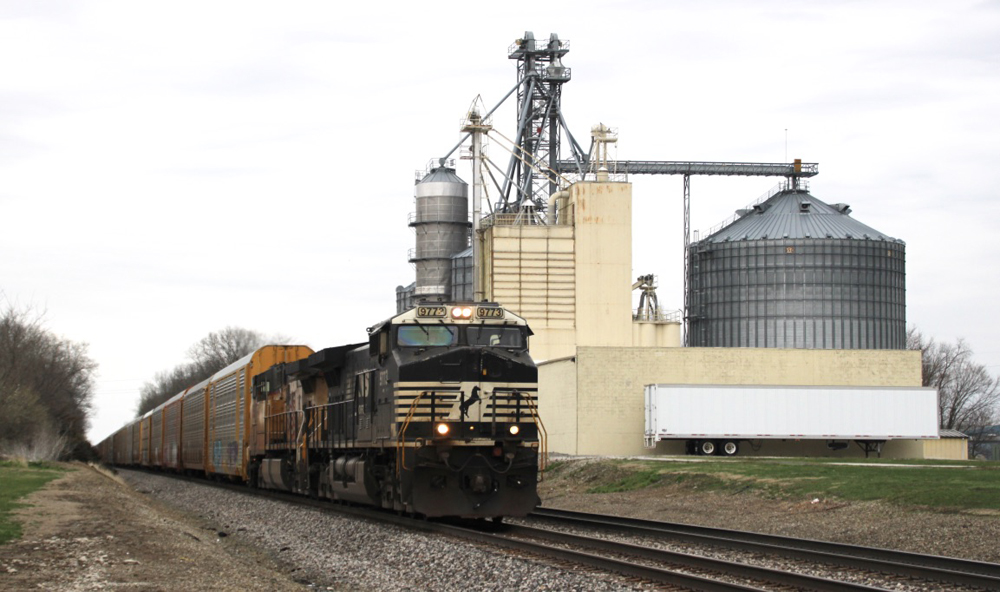
The publicly traded U.S. Class I railroads are putting more of an emphasis on service and volume growth in the annual incentive plans they offer to their executives.
It’s a clear sign, analysts say, that the railroads are shifting into growth mode after years spent concentrating on reducing their operating ratios in a quest for higher profits.
“People will move toward what they are incented to do … it’s not just a symbolic move,” says independent analyst Anthony B. Hatch. The incentive changes are part of what Hatch calls the “pivot to growth” that follows the implementation of the ultra-lean Precision Scheduled Railroading operating model.
The annual incentive plan changes are the most pronounced at Norfolk Southern, which in December unveiled a long-term service and growth strategy.
Last year, the annual bonus formula was built 50% on operating ratio improvement, 30% on operating income, and 20% on corporate goals. For 2023 the operating ratio component is gone. The formula is now based 40% on operating income, 30% on revenue growth, 10% on merchandise on-time performance, 10% on intermodal on-time performance, 5% on improving the employee injury rate, and 5% on improving the train accident rate.
CSX Transportation reduced its operating ratio component from 35% a few years ago. Now the short-term bonuses are weighted 30% on operating income, 30% operating ratio, 10% new traffic growth, 10% safety, 10% fuel efficiency, and 10% trip-plan compliance.
Union Pacific has tweaked the annual incentive formula it introduced in 2018. The formula is based 35% on operating income, 35% on operating ratio, 20% on the “corporate scorecard,” and 10% on individual performance. The scorecard is where UP has introduced carload growth, market share, trip-plan compliance, and net promoter score, which is a measure of customer satisfaction. The other scorecard components include employee engagement, personal injury rate, reportable derailment rate, and renewable fuel blend.
The annual bonus programs can provide up to 25% of an executive’s total compensation and are designed, along with long-term incentive plans, to ensure that management pursues the goals set by the board of directors.
Nick Little, director of railway education at Michigan State University’s Center for Railway Research and Education, is encouraged by the changes in management compensation. “I would best sum it up that NS and CSX are better aligning their executive incentives with stakeholder satisfaction rather than shareholder satisfaction,” he says. “Next, I’d like to see an element of the incentive scheme based upon a customer experience index and also upon staff/employee satisfaction indices.”
Peter Swan, an associate professor of logistics and operations management at Penn State Harrisburg, says there’s no question incentives work. But they can backfire if they’re not carefully structured.
In the 1980s, when Swan was in the marketing department at CSX, there was an incentive to reduce fuel costs. The easiest way to do that is reduce horsepower-per-ton ratios, Swan says, which CSX management did with gusto. The result was burned out traction motors, a network slowdown, and more trains holding for power — all of which took a toll on service and likely raised costs overall.
Gaining new business is far harder than cutting costs. Among the things railroads need to do to grow, Swan says, is go beyond incentives and restore surge capacity in the form of crews, locomotives, and freight cars.
Getting away from managing to the operating ratio also will help. “If you manage just by operating ratio you really limit growth,” Swan says.
Little agrees. “A focus on OR (or net profit margin) as a sole driver of company performance is, and always has been, a shorter term goal since there are structural limits to how far O.R. can be cut or margins increased without losing business,” he says.
But a focus on service and growth won’t necessarily nudge the operating ratio upward. “If you’re running a railroad right — for customers, in ways that the Surface Transportation Board would approve of — your O.R. should not suffer,” Hatch says. “It should get better.”
Swan says incentive plans that balance financial, service, growth, and safety goals are overdue. “Right now the industry has successfully angered every stakeholder group except shareholders,” he says.
The Canadian railways, which have grown at more than three times the rate of the big four U.S. systems over the past decade, also include service and customer elements.
Canadian National’s annual incentive plan is based 70% on financial performance (35% on operating ratio, 35% on operating income, 30% on free cash flow); 20% on corporate strategic performance (weighted equally on fuel efficiency, employee engagement, and customer centricity), and 10% on safety.
Canadian Pacific’s plan, set before its merger with Kansas City Southern, is based 35% on operating ratio, 35% on operating income, 10% on the train accident rate, 10% on the employee injury rate, and 10% on trip-plan compliance.














I agree with Paul…
I’ve got three and a half years to retire…I’d like to see this bear significant and copious fruit before I go!
Can we get a “Howl Lah Lu Lu”?
It will be hard to change management mentality. Working as a conductor, I once asked a division gm why we didn’t go after more smaller business customers. I was told there wasn’t enough money there. I really hope they stick to the new plan.
What a novel idea; will wonders never cease?
Likely post-East Palestine posturing that will quickly evaporate after the CEO gets fired by the investors as soon as the OR increase or the dividends drop.
Lets hope that the Railroads are serious about this. A move in the right direction.